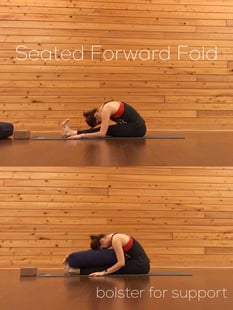The way we move our bodies has a profound impact on our brains—our moods, sleep, interpersonal communication, and emotional intelligence. MRI scans show that yoga in particular can make your brain more calm and self-aware.
Out of the hundreds of yoga poses, some are naturally calming for the parasympathetic nervous system more than others, which take the body from fight-or-flight mode into rest-and-digest. Especially in stressful times, grounding and centering ourselves are vital! See what poses will help the most.
Estimated reading time: 3 minutes ♥ A yoga practice: a lifetime endeavor

The Essential Yoga Practice for Grounding and Relaxation
This set of basic yoga poses can be done at home with simple props (try pillows instead of a bolster if you don’t have one) and can have a noticeable impact on your mood and energy level. Try practicing a few or all of these postures (“asanas”) in the morning to start your day mindfully. Or do them before bed to slow racing thoughts and prepare for solid rest.
Stay in each shape for 3-5 minutes at least. While you do, you can add the breathing techniques we covered in the blog on 7 Ways to Effectively Handle Anxiety. Most importantly, just breathe and focus on the sensations of your body touching the ground or supportive props. Notice how the way you move your body—or rest it—can affect your mind.
NATURAL CALMING YOGA POSITIONS
 Child’s Pose
Child’s Pose
- Sit on your heels, with knees wider than hip distance apart
- Walk your hands forward until your forehead touches (or comes close to) the mat
- If your head doesn’t touch, use a bolster/block/pillow for support under your head
- If your feet don’t lay flat, roll a blanket or towel under your ankles
- Reach your body in opposite directions; fingers forward, hips back
Hero’s Pose
- Sit on a block, bolster, or pillow with your knees touching and your feet wider than hip-distance
- Sip up tall with a long spine
- Relax your shoulders and jaw
- Tuck your chin slightly, so the back of your neck is long
- Rest your hands on your thighs
*Important: keep your knees touching
Standing Fold
- Stand with feet hip-distance or wider
- Fold forward
- Bend your knees softly
- Put your pinky fingers in opposite elbow creases (“box your arms”)
- Relax your head, shoulders, neck, and arms
- You can sway gently side-to-side and forward-and-back
*Important: keep your knees softly bent
Seated Forward Fold
- Sit upright with your legs extended in front of you
- If your back is rounding, sit on a block/blanket/bolster to lift your hips
- Fold forward, chest toward your thighs
- Deliberately relax your head
- You can bend your knees. For more support, roll a towel/blanket and place it under the backs of your knees
- Rest your hands by your sides
Baddha Konasana (Butterfly Pose)
- Sit upright with the soles of your feet together and your knees spread wide
- Sit on a block/blanket/bolster if necessary
- Fold forward, letting your spine round and your head relax
- You can place a block or bolster under your head for support
- You can place blocks under your knees if they are very high off the ground
Half Pigeon Pose
- Bring your front shin parallel to the top edge of your mat (or as close to parallel as possible, with your knee on one side and your foot toward the other side)
- Point your back leg straight behind you
- Point both hips straight forward; try not to roll to one side or the other
- Fold forward. Bring your forearms or forehead to the floor
- Relax your neck, jaw, and hips
- You can put a block, blanket, or bolster under one hip if you are tilting to one side
*Important: if you feel any knee pain or cannot point both hips straight forward, do Pigeon Pose on your back
Reclining Pigeon: lay on your back and make a figure 4 by crossing one ankle on your other thigh. Relax your head and neck to the floor. You can pull your legs toward you for a deeper stretch.
Related reading: "Deep Breath: the Best Yoga Poses for Anxiety."
Happy Baby Pose
- Lay on your back with your knees hugged to your chest
- Widen your knees and reach inside your legs for your ankles or the arches of your feet
- Pull your knees down toward your armpits
- Relax your head and neck onto the floor
 Supine Twist
Supine Twist
- Lay on your back with your knees hugged to your chest
- Keeping your knees best, drop your knees to the left
- Reach your arms out from your shoulders, making a letter T on the floor
- Drop your head to the right
- After a few minutes of deep breathing, switch your knees to the right and your head to the left.
These are a few of the best yoga poses for grounding and relaxation. Remember, you should not feel pain in the poses. Discomfort, however, is normal and even beneficial, as it means you are working your body in a different way and targeting tight muscles or tendons. Take time to relax in each pose. 3 to 5 minutes is best. While you stay in the pose, focus on lengthening your inhales and exhales and notice where your body is touching the ground.
For more on mindfulness, check out "Why Mindfulness Is Important And 3 Simple Practices."
To learn how to deal with stress to achieve emotional well-being or to learn more ways to cultivate inner peace, check out our Heartmanity coaching programs.
For more to develop healthy habits, check out our blogs on Habits for Health.













